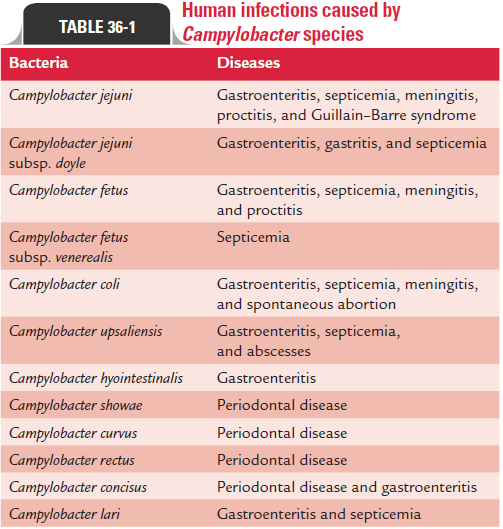Chapter: Microbiology and Immunology: Bacteriology: Campylobacter and Helicobacter
Clinical Syndrome - Campylobacter
Clinical Syndrome
Campylobacter spp. infections in humans can be broadly classified into two major groups: (a) enteric infections and (b) extraintestinal infections.
◗ Enteric infections
C. jejuni is the most important species associated with humanenteric infections. Other Campylobacter species are also associ-ated with enteric infections; these are listed in Table 36-1. The clinical manifestations of enteric infections caused by all theCampylobacter species including C. jejuni are similar. Waterydiarrhea is the main manifestation and occurs in approxi-mately 10% of children. The condition is also associated with abdominal pain, malaise, myalgia, headache, and vomiting. The condition is self-limiting. C. fetus may cause intermit-tent diarrhea and nonspecific abdominal pain. C. lari has also been reported to cause recurrent mild diarrhea in children.Campylobacter upsaliensis may also cause diarrhea.

◗ Extraintestinal infections
Bacteremia: Bacteremia is the most important extraintestinalmanifestation. Bacteremia caused by C. jejuni is uncommon and occurs in patients with immunodeficiency, chronic disease, and in old individuals. Blood stream infections and bacteremia by C. fetus are rare.
Perinatal infection: C. fetusis the most importantCampylo-bacter species known to cause perinatal infection because of itsaffinity for the genital tract and due to its tropism for fetal tis-sue. Abortion, stillbirth, and premature labor are the common manifestations. Premature babies show signs and symptoms of sepsis. C. jejuni is rarely associated with perinatal infection. C. hyointestinalis causes occasional bacteremia in immunocom-promised hosts. Guillain–Barre syndrome, reactive arthritis, hemolytic uremic syndrome, and Reiter’s syndrome are some of the noted complications associated with Campylobacter infection. Reactive arthritis is another condition seen in patients positive for HLA-B27 and is commonly seen in young patients.
Guillain–Barre syndrome:It is an autoimmune diseasebelieved to be due to molecular mimicry of terminal tetra-saccharide of LPS of C. jejuni and glycosphingolipid pres-ent on the surface of peripheral nerve. This is a disease of peripheral nerves and is characterized by ascending paraly-sis. A rare serotype of C. jejuni called Penner (LPS type O: 19) is associated with this condition.
Related Topics